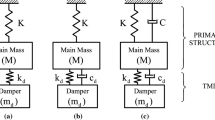Abstract
The optimisation of earthquake resistance of high buildings by multi-tuned mass dampers was investigated using bionic algorithms. In bionic or evolutionary optimisation studies the properties of parents are crossed and mutated to produce a new generation with slightly different properties. The kids which best satisfy the object of the study, become the parents of the next generation. After a series of generations essential improvements of the object may be observed. Tuned mass dampers are widely used to reduce the impact of dynamic excitations on structures. A single mass system and multi-mass oscillators help to explain the mechanics of the dampers. To apply the bionic optimisation strategy to high buildings with passive tuned mass dampers subject to seismic loading a special beam element has been developed. In addition to the 6 degrees of freedom of a conventional beam element, it has 2 degrees of freedom for the displacements of the dampers. It allows for fast studies of many variants. As central result, efficient designs for damping systems along the height of an edifice are found. The impact on the structure may be reduced essentially by the use of such dampers designed to interact in an optimal way.
Similar content being viewed by others
References
Den Hartog J P. Mechanical Vibrations, 4th Edition, McGraw-Hill Book Company, New York, USA, 1956.
Nawrotzki P, Dalmer F. Der Einfluss von Schwingungstilgern auf die Standsicherheit und Gebrauchstauglichkeit von Bauwerken, D-A-CH Tagung 2005, Retrieved from http://www.gerb.com/de/bibliothek/downloads/dokumente/ aKoeln.pdf. (in German)
Chopra A K. Dynamics of Structures: Theory and Applications to Earthquake Engineering, Prentice-Hall, Upper Saddle River, New Jersey, USA, 2000.
Li C. Performance of multiple tuned mass dampers for attenuating undesirable oscillations of structures under the ground acceleration. Earthquake Engineering & Structural Dynamics, 2000, 29, 1405–1421.
Li C. Optimum multiple tuned mass dampers for structures under the ground acceleration based on DDMF and ADMF. Earthquake Engineering & Structural Dynamics, 2002, 31, 897–919.
Ji H-R, Moon Y-J, Kim C-H, Lee I-W. Structural Vibration Control Using Semiactive Tuned Mass Damper. Proceedings of the Eighteenth KKCNN Symposium on Civil Engineering-KAIST6, Taiwan, 2005.
Fu T S, Johnson E A. Control strategies for a distributed mass damper system. Proceedings of the American Control Conference, St. Louis, MO, USA, 2009, 3921–3925.
De Angelis M, Perno S, Reggio A. Dynamic response and optimal design of structures with large mass ratio TMD. Earthquake Engineering & Structural Dynamics, 2011, 40, doi: 10.1002/eqe.1117.
Rechenberg I. Evolutionsstrategie ′94, Frommann-Holzboog, Stuttgart, Germany, 1994.
Gen M, Cheng R. Genetic Algorithms & Engineering Optimization, John Wiley & Sons, New York, USA, 2000.
Michalewicz Z. Genetic Algorithms+Data Structures=Evolution Programs, Springer, New York, USA, 1996.
Steinbuch R. Successful application of evolutionary algorithms in engineering design. Journal of Bionic Engineering, 2010, 7, S199–S211.
Bozorgnia Y, Bertero V V. Earthquake Engineering, CRC Press, Boca Raton, USA, 2004.
Towhata I. Geotechnical Earthquake Engineering, Springer Series in Geomechanics and Geoengineering, Springer, Berlin, 2008.
Eddy N. Taipei 101’s 730-Ton Tuned Mass Damper, [2011-02-01], http://www.popularmechanics.com/technology/gadgets/new s/1612252
Berkeley. Kobe Earthquake 1995/01/16 20:46, Station Takarazuka, [2011-02-01], http://peer.berkeley.edu/smcat/data/ath/KOBE/TAZ-UP.AT2, http://peer.berkeley.edu/smcat/data/ath/KOBE/TAZ000.AT2, http://peer.berkeley.edu/smcat/data/ath/KOBE/TAZ090.AT2
Hodges D H, Pierce G A. Introduction to Structural Dynamics and Aeroelasticity, Cambridge University Press, Cambridge, UK, 2002.
Li S. Evolutionary Optimization of Earthquake Resistance Capacity for High Buildings, Unpublished Master Thesis, University of Reutlingen, Germany, 2010.
Author information
Authors and Affiliations
Corresponding author
Rights and permissions
About this article
Cite this article
Steinbuch, R. Bionic optimisation of the earthquake resistance of high buildings by tuned mass dampers. J Bionic Eng 8, 335–344 (2011). https://doi.org/10.1016/S1672-6529(11)60036-X
Published:
Issue Date:
DOI: https://doi.org/10.1016/S1672-6529(11)60036-X




